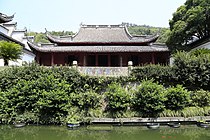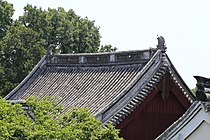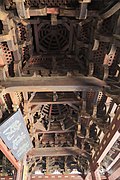| Revision as of 21:56, 7 November 2015 editDMacks (talk | contribs)Edit filter managers, Autopatrolled, Administrators186,624 editsm Reverted edits by Krzyhorse222 (talk) to last version by Sevilledade← Previous edit | Revision as of 20:13, 16 March 2016 edit undoBDD (talk | contribs)Autopatrolled, Administrators111,940 editsm BDD moved page Baoguo Temple (Ningbo) to Baoguo Temple: Unnecessary disambiguationNext edit → |
| (No difference) | |
Revision as of 20:13, 16 March 2016
| This article does not cite any sources. Please help improve this article by adding citations to reliable sources. Unsourced material may be challenged and removed. Find sources: "Baoguo Temple" Zhejiang – news · newspapers · books · scholar · JSTOR (March 2011) (Learn how and when to remove this message) |
29°58′57″N 121°30′58″E / 29.98250°N 121.51611°E / 29.98250; 121.51611 The Baoguo Temple (Chinese: 保国寺; pinyin: Bǎoguósì) is a Mahayana Buddhist temple located in the Jiangbei district, 15 kilometres (9.3 mi) north of Ningbo, in Zhejiang Province, People's Republic of China. It is noted as the second oldest surviving wooden structure in southern China since the main hall of the present temple dates back to 1013 AD during the Northern Song dynasty.
History
The temple was originally called the Lingshan Temple (灵山寺), but in 880 AD, during the Tang Dynasty it was renamed the Baoguo Temple. The main hall was rebuilt in 1013 AD, during the Northern Song dynasty, and is one of the oldest and most well preserved wooden constructions in China. The temple also contains columns dating to the Tang Dynasty, a hall built during the Ming Dynasty, and two halls and towers of the Qing Dynasty.
Today the temple is a tourist attraction, and many of its rooms and halls are used to house various exhibitions, including:
- Guanyin statues
- Confucian bronzes
- Ningbo furniture
- Traditional Chinese wedding attire
- Carved stone screens
- Miscellaneous architectural pieces from the temple compound
- Famous places around China
Transport
The temple can be accessed by bus 332 from Ningbo city. The ride takes approximately 35 minutes.
Entry
Standard tickets are 20 yuan per person. Guides are available for an additional fee.
See also
External links
- Baoguo Temple Official Website Template:Zh icon
- Baoguo Temple, English Description on Ningbo City Website
| Zhejiang topics | |
|---|---|
| Hangzhou (capital) | |
| General | |
| Geography | |
| Education | |
| Culture | |
| Cuisine | |
| Visitor attractions | |















